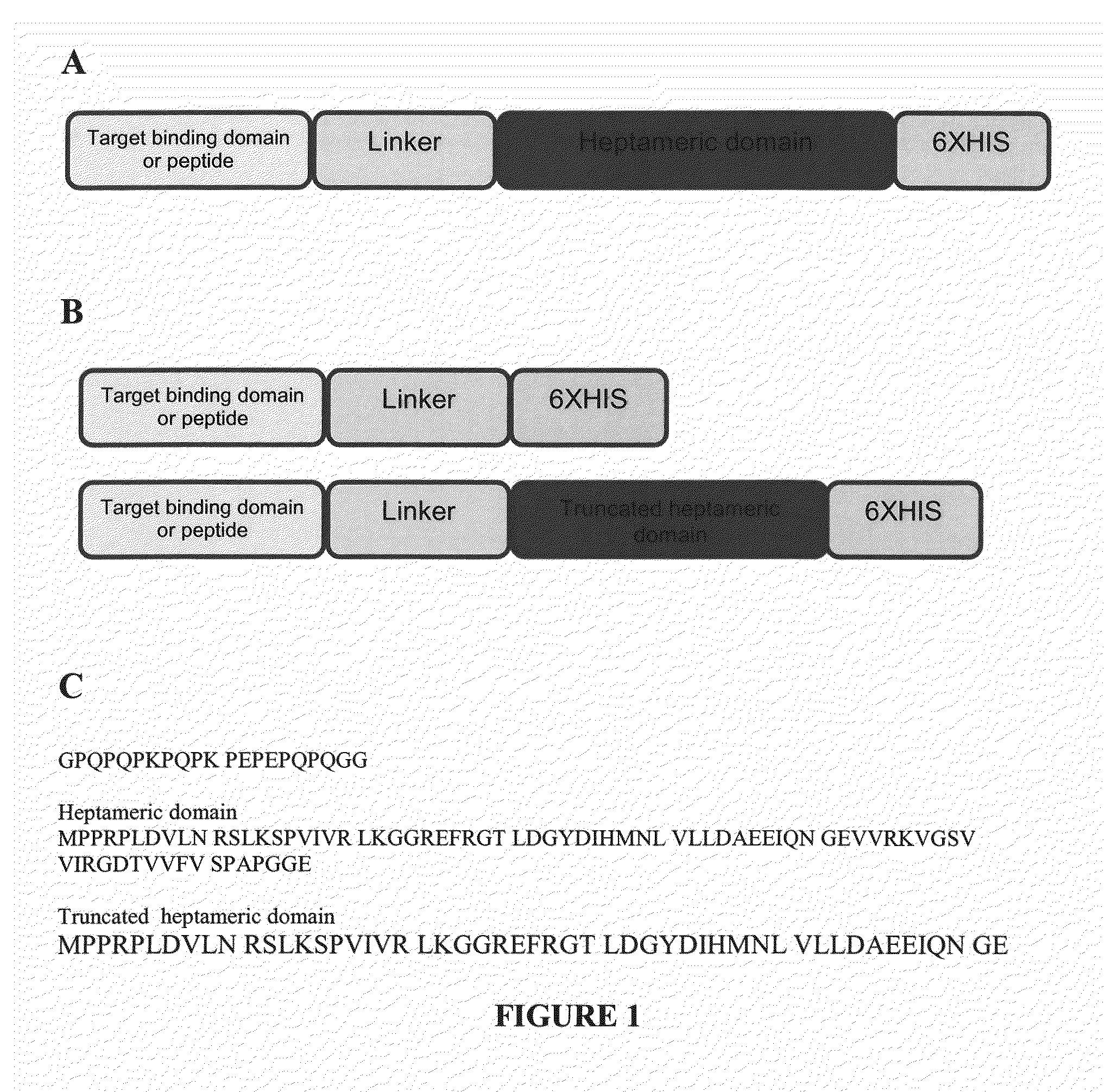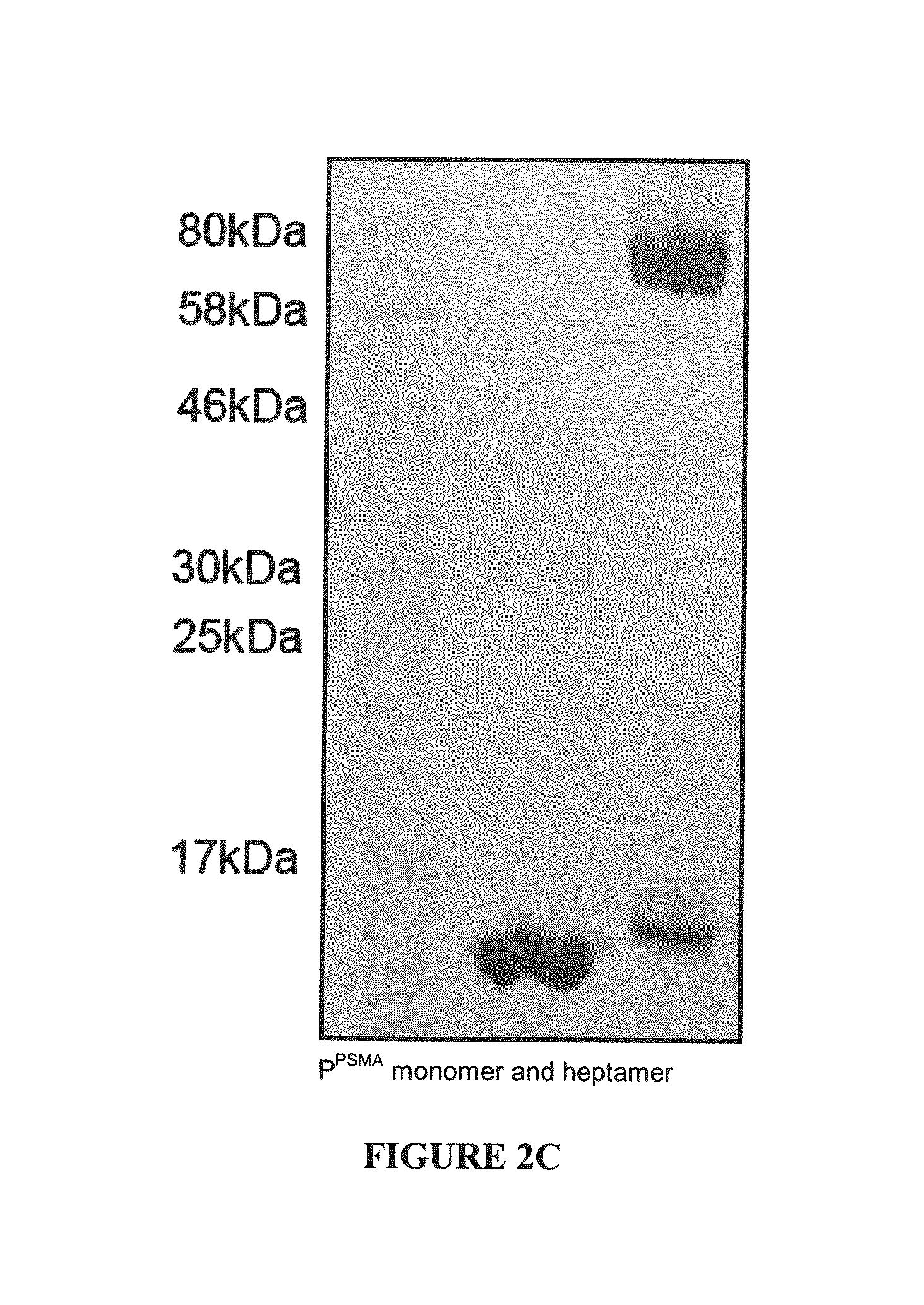Methods and Compositions for Heptameric Targeting Ligands
a technology of heptameric targeting and ligands, applied in the direction of peptide/protein ingredients, depsipeptides, fusion polypeptides, etc., can solve the problems of limited process, slow process, difficult to achieve, and insufficient monovalent binding,
- Summary
- Abstract
- Description
- Claims
- Application Information
AI Technical Summary
Benefits of technology
Problems solved by technology
Method used
Image
Examples
example 1
REFERENCES FOR EXAMPLE 1
[0121]1. Deyev, S. M. & Lebedenko, E. N. (2008). Multivalency: the hallmark of antibodies used for optimization of tumor targeting by design. Bioessays 30, 904-918.[0122]2. Pluckthun, A & Pack, P (1997). New protein engineering approaches to multivalent and bispecific antibody fragments. Immunotechnology 3, 83-105,[0123]3. Crothers D. M. & Metzger H (1972). The influence of polyvalency on the binding properties of antibodies. Immunochemistry 9, 341-357.[0124]4, Trejtnar F & Laznicek, M (2002). Analysis of renal handling of radiopharmaceuticals. Q J Nuc Med 46, 181-194.[0125]5. Borsi L., Balza E, Carnemolla, B., Sassi F., Castellani P (2003). Selective targeted delivery of THF alpha to tumor blood vessels. Blood 102, 4384-4392.[0126]6. Pack, P., Muller, K., Zahn, R.& Pluckthun, A. (1995). Tetravalent miniantibodies with high avidity assembling in Escherichia coli. J Mol Biol 246, 28-34.[0127]7. Kubetzko, S., Balic, E., Waibel, R., Zangemeister-Wittke, U & Pluc...
example 2
REFERENCES FOR EXAMPLE 2
[0174]1. Deyev S M, Lebedenko E N (2008) Multivalency: the hallmark of antibodies used for optimization of tumor targeting by design. Bioessays, 30, 904-918.[0175]2. Bird R E, Hardman K D, Jacobson J W, Johnson S, Kaufman B M. (1988) Single-chain antigen binding proteins. Science, 242, 423-426.[0176]3. Yokota T, Milenic D E, Whitlow M, Schlom J (1992) Rapid tumor penetration of a single chain Fv and comparison with other immunoglobulin forms. Cancer Res, 52, 3402-3408.[0177]4. Pluckthun A, Pack P (1997) New protein engineering approaches to multivalent and bispecific antibody fragments. Immunotechnology, 3, 83-105.[0178]5. Crothers D M, Metzger H (1972) The influence of polyvalency on the binding properties of antibodies. Immunochemistry, 9, 341-357.[0179]6. Trejtnar F, Laznicek M (2002) Analysis of renal handling of radiopharmaceuticals. Q J Nuc Med, 46, 181-194.[0180]7. Borsi L, Balza E, Carnemolla B, Sassi F, Castellani P (2003) Selective targeted delivery...
example 3
A 7Ring (Heptamer) that Delivers Therapeutic RNAs and Small Molecule Drugs
[0204]Another application of this invention is for facile self-loading of oligonucleotide or small molecule payloads through self-assembly without the need of any chemical conjugation. The introduction of a targeting ligand to si / shRNA-containing particles, either directly or indirectly, faces several major challenges. The technology of this invention uniquely addresses the challenge. The Sm or Sm-like (Lsm) protein that is used for self-assembly is involved in a variety of RNA processing events in all eukaryotic organisms. Its doughnut-shaped ring structure has a unique function to accommodate and specifically bind to uracil rich RNAs. This allows for the self-loading of nucleic acid-based payloads such as (rU)10-containing si / shRNAs and micro RNAs (miRNAs) simply by adding-mixing (FIG. 17A).
[0205]In addition to the self-loading of oligo(rU)-containing si / shRNAs, the heptamer (7Ring) of this invention can als...
PUM
| Property | Measurement | Unit |
|---|---|---|
| Composition | aaaaa | aaaaa |
| Therapeutic | aaaaa | aaaaa |
| Pharmaceutically acceptable | aaaaa | aaaaa |
Abstract
Description
Claims
Application Information
 Login to View More
Login to View More - R&D
- Intellectual Property
- Life Sciences
- Materials
- Tech Scout
- Unparalleled Data Quality
- Higher Quality Content
- 60% Fewer Hallucinations
Browse by: Latest US Patents, China's latest patents, Technical Efficacy Thesaurus, Application Domain, Technology Topic, Popular Technical Reports.
© 2025 PatSnap. All rights reserved.Legal|Privacy policy|Modern Slavery Act Transparency Statement|Sitemap|About US| Contact US: help@patsnap.com



